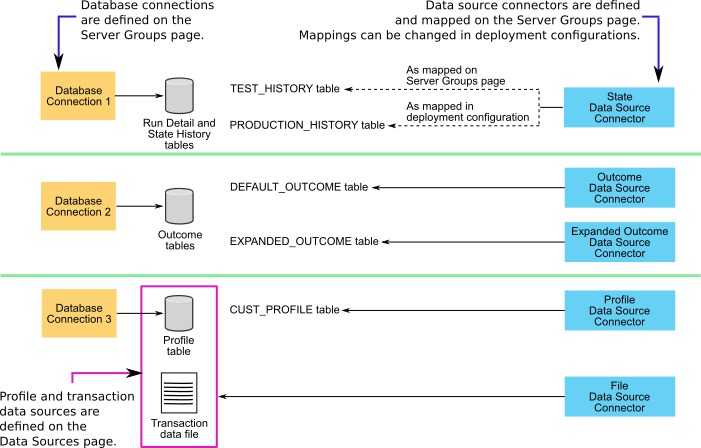About data source connectors
Data source connectors enable the system to connect to the transaction, profile, State History, and Outcome data sources that you have defined. The types of data source connectors are described in this section.
File Connectors
Use flat file data source connectors to connect to transaction and profile data that is in file format.
Table Connectors
Use table data source connectors to connect to the following data sources.
- Profile data that is in database table format
- All State History tables
- Outcome data that you want to be written to database tables
You have the option to make table connectors sharable. The sharable feature works as follows.
- A sharable connector can be used in more than one server group.
- Sharable connectors can be mapped on the Data Source Mapping tab of the Server Groups page and on the Deployment tab of a workspace. Table connectors that are not sharable can be mapped only on the Deployment tab of a workspace.
For example, you might want to have connectors for Outcome and State History tables that are not shared and can be used only by the deployment configuration used for production. You might also want sharable table connectors so you can map them to the same Outcome and State History tables for all test workspaces.
Regardless of whether a connector is sharable, a table connector can be mapped to only one data source.
There are four types of table data source connectors.
- State
-
Used to connect to your State History tables.
- Profile
- Used to connect to your profile data that is in database table format.
- Outcome
- Used when you want Outcome data to be stored in database tables in the XML format used by previous versions of Opportunity Detect.
- Expanded Outcome
- Used when you want Outcome data to be stored in database tables in a form that external systems or HCL® Campaign can use more easily than the format provided by the Outcome connector.
Web Service
You can use the Web Service connector to connect to transaction and Outcome data coming from or being sent to the Opportunity Detect web service.
If you use the web service for transaction data and you also use profile data, the profile data must be in database table format.
You do not have to create this type of connector. It exists in the system by default.
For details about the Java classes that must be developed to use the Web Service data source connector, see "Web Service data source connector for input and output in Opportunity Detect" in the HCL Opportunity Detect Administrator's Guide.
Queue
If you have applied Fix Pack 9.1.1.2 for HCL Opportunity Detect and HCL Interact Advanced Patterns, you can use this connector for real time operation.
For additional information on setting up Queue data source connectors, see "Real time processing in Opportunity Detect" in the HCL Opportunity Detect Administrator's Guide.
Default TCP Connector
Used by the system with HCL Interact Advanced Patterns when integration with HCL Interact is implemented.
You do not have to create this type of connector. It exists in the system by default.
Example of data source connector configuration
The following diagram illustrates a possible data source configuration, showing the relationship between database connections, data source connectors, and the data sources used in Opportunity Detect.

